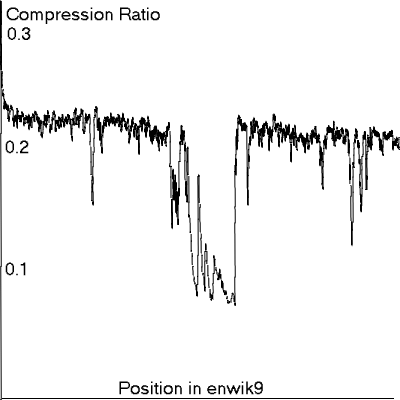
Matt Mahoney
Last update: Dec. 17, 2006. History
The test data for the Large Text Compression Benchmark is the first 109 bytes of the English Wikipedia dump on Mar. 3, 2006. http://download.wikipedia.org/enwiki/20060303/enwiki-20060303-pages-articles.xml.bz2 (1.1 GB or 4.8 GB after decompressing with bzip2). Results are also given for the first 108 bytes, which is also used for the Hutter Prize. These files have the following sizes and checksums:
File Size (bytes) MD5 (GNU md5sum 1.22) SHA-1 (SlavaSoft fsum 2.51) ------ ------------- -------------------------------- ---------------------------------------- enwik8 100,000,000 a1fa5ffddb56f4953e226637dabbb36a 57b8363b814821dc9d47aa4d41f58733519076b2 enwik9 1,000,000,000 e206c3450ac99950df65bf70ef61a12d 2996e86fb978f93cca8f566cc56998923e7fe581
Download in zip format: enwik8.zip (35,012,219 bytes) enwik9.zip (310,188,783 bytes).
Download in bzip2 format: enwik8.bz2 (29,008,758 bytes) enwik9.bz2 (253,977,891 bytes).
Download in ppmd var. J format (requires 256 MB free memory): enwik8.pmd (21,388,296 bytes) enwik9.pmd (183,964,915 bytes).
The data is UTF-8 encoded XML consisting primarily of English text. enwik9 contains 243,426 article titles, of which 85,560 are #REDIRECT to fix broken links, and the rest are regular articles. The example fragment below shows a redirection of "AdA" to "Ada programming language" and the start of a regular article with title "Anarchism".
The data is UTF-8 clean. All characters are in the range U'0000 to U'10FFFF with valid encodings of 1 to 4 bytes. The byte values 0xC0, 0xC1, and 0xF5-0xFF never occur. Also, in the Wikipedia dumps, there are no control characters in the range 0x00-0x1F except for 0x09 (tab) and 0x0A (linefeed). Linebreaks occur only on paragraph boundaries, so they always have a semantic purpose. In the example below, lines were broken at 80 characters, but in reality each paragraph is one long line.
The data contains some URL encoded XHTML tags such as <ref> ... </ref> and <br /> which decode to <ref> ... </ref> (citation) and <br /> (line break). However, hypertext links have their own encoding. External links are enclosed in square brackets in the form [URL anchor text]. Internal links are encoded as [[Wikipedia title | anchor text]], omitting the title and vertical bar if the title and anchor text are identical. Non-English characters are sometimes URL encoded as &#945;, meaning α (Greek alpha, α), but are more often coded directly as a UTF-8 byte sequence.
<page>
<title>AdA</title>
<id>11</id>
<revision>
<id>15898946</id>
<timestamp>2002-09-22T16:02:58Z</timestamp>
<contributor>
<username>Andre Engels</username>
<id>300</id>
</contributor>
<minor />
<text xml:space="preserve">#REDIRECT [[Ada programming language]]</text>
</revision>
</page>
<page>
<title>Anarchism</title>
<id>12</id>
<revision>
<id>42136831</id>
<timestamp>2006-03-04T01:41:25Z</timestamp>
<contributor>
<username>CJames745</username>
<id>832382</id>
</contributor>
<minor />
<comment>/* Anarchist Communism */ too many brackets</comment>
<text xml:space="preserve">{{Anarchism}}
'''Anarchism''' originated as a term of abuse first used against early [[working
class]] [[radical]]s including the [[Diggers]] of the [[English Revolution]] an
d the [[sans-culotte|''sans-culottes'']] of the [[French Revolution]].[http://uk
.encarta.msn.com/encyclopedia_761568770/Anarchism.html] Whilst the term is still
used in a pejorative way to describe ''"any act that used violent means to
destroy the organization of society"''<ref>[http://www.cas.sc.edu/so
cy/faculty/deflem/zhistorintpolency.html History of International Police Coopera
tion], from the final protocols of the "International Conference of Rome fo
r the Social Defense Against Anarchists", 1898</ref>, it has also bee
n taken up as a positive label by self-defined anarchists.
The word '''anarchism''' is [[etymology|derived from]] the [[Greek language|Gree
k]] ''[[Wiktionary:&#945;&#957;&#945;&#961;&#967;&#943;&
amp;#945;|&#945;&#957;&#945;&#961;&#967;&#943;&#945;
]]'' ("without [[archon]]s (ruler, chief, king)"). Anarchism as a [[po
litical philosophy]], is the belief that ''rulers'' are unnecessary and should b
The graph below shows the incremental compressed size of enwik9 over a sliding window of about 2-4 MB when compressed with ppmd var. J with options -o10 -m256 -r1 (maximum compression as in the main table). The horizontal axis is the position in the file, from 0 to 1 GB. The vertical axis is the compression ratio on a scale of 0 to 0.3. The graph was produced by modifying the source code for ppmd to print the graph coordinates, then smoothing the data for display.

Incremental compression ratio of enwik9 with ppmd var. J set for maximum compression.
The dip in the middle of the graph is due to a large group of articles on towns in the US written in a similar style that appear to be generated automatically from a table of census data. A sample of titles from this region appears below. Unrelated articles are occasionally mixed in.
Springboro, Pennsylvania
Steuben Township, Pennsylvania
Summerhill Township, Crawford County, Pennsylvania
Summit Township, Crawford County, Pennsylvania
Titusville, Pennsylvania
Townville, Pennsylvania
Troy Township, Crawford County, Pennsylvania
Union Township, Crawford County, Pennsylvania
Venango, Pennsylvania
Venango Township, Crawford County, Pennsylvania
Vernon Township, Pennsylvania
The following diagrams show the distribution of string matches of length 1 (black), 2 (red), 4 (green), and 8 (blue). The horizontal axis represents the position in the file. The vertical axis shows the distance backwards to the previous match on a logarithmic scale. The major tick marks reading upwards are 1, 10, 100, 1000, etc.

enwik8
enwik8 is fairly uniform. The blue band at the top shows that matches of length 8 are most often separated by at least 105 bytes (5 major tick marks) up to the entire length of the file. The green band shows that matches of length 4 are most commonly separated by 103 to 104 bytes. The red band shows that matches of length 2 are separated by about 10 to 300 bytes. The gray band shows that single byte matches are usually separated by 1 or by 3 to about 10. The light gray band shows an absence of matches separated by 2, such as "aba".
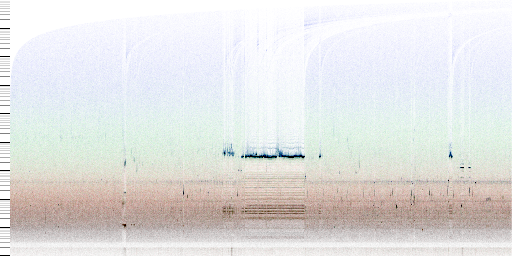
enwik9
The highly compressible region in the center of enwik9 is clearly visible. The dark blue-green band shows that there are frequent matches of length 4-8 separated by about 3000 bytes, the length of one article. The articles are fairly uniform in length, but not exactly so. The dark red bands below it show a separation of around 20-80 bytes, typical of tables.
The blue region extends all the way to the top of the image, showing redundancy across the entire file. Thus, a compressor would benefit by using lots of memory. Breaking the file into smaller, separately compressed pieces would hurt compression.

enwik6
This shows the first 106 bytes of data, essentially zooming into the first 1% of enwik8 or first 0.1% of enwik9. The clear, vertical bands show regions consisting primarily of XML to encode #REDIRECTs. These have a regular, repeating structure of length 300-400 bytes. The white vertical bands extending upwards show that there are no long distance matches backwards (they occur closer). The upward curving white bands show the absence of long distance forward matches.
These images were generated with the FV program. Download: fv.cpp (7KB, GPL, C++), fv.exe (25KB, 32-bit Windows). The program uses 512 MB memory. It took about 14 minutes to generate the image for enwik9 on a 2.2 GHz Athlon-64 under WinXP Home. The program outputs in .bmp format. You will need another program to convert to .jpg, .png, etc.
For comparison, the Calgary corpus (concatenated) is shown below. The image was hand edited to add the labels. The repetitive structure of book1 (70-80), geo (4), obj2 (4), and pic (216) is clearly visible. The image also shows that there is redundancy between text files but not the binary files. (More FV results by Leonardo Maffi).
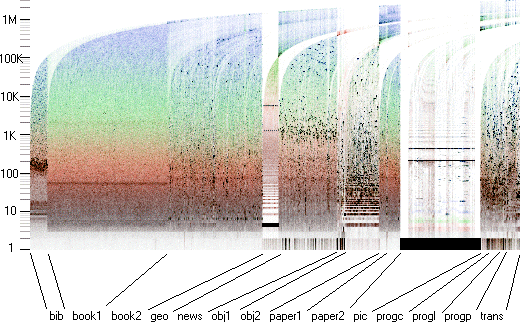
Calgary corpus (image edited to add labels)
The table below shows the frequency distribution for the 100 most common words in enwik9, as well as selected ranks of lower frequency. The file was parsed by considering all sequences of English letters (A-Z, a-z) as single words, and all other single characters as words. The most common token is the space, which occurs 139 million times. ^J is the linefeed character. Upper and lower case are considered distinct.
Freq Rank
139132610 1
20216224 2 ]
20214205 3 [
13147025 4 ^J
9578832 5 .
8824782 6 '
7978922 7 ,
6498257 8 the
6199271 9 ;
6037325 10 1
5754062 11 0
5277489 12 /
5274001 14 < >
5084982 15 &
4907106 16 |
4848627 17 of
4721386 18 2
4252985 19 =
3542288 20 -
3536470 21 :
3239688 22 9
3050674 23 and
2736971 24 3
2596182 25 5
2579245 26 4
2523537 27 )
2521806 28 (
2490470 29 *
2443325 30 8
2372995 31 6
2288680 32 in
2130130 33 a
2122603 34 to
2005136 35 7
1875367 36 quot
1630357 37 is
1420384 38 id
1304048 39 The
1152218 40 lt
1151080 41 gt
970827 42 %
968882 43 s
919535 44 amp
901320 45 }
901242 46 {
861221 47 for
852516 48 are
815600 49 was
741327 50 as
715225 51 by
707706 52 with
638091 53 from
606095 54 that
579119 55 on
541826 56 title
532311 57 or
530859 58 #
522024 59 page
513474 60 text
494564 61 _
489280 62 revision
487656 63 contributor
486934 64 timestamp
486902 65 "
442286 66 Ã
426510 67 sup
414409 68 at
412849 69 http
410993 70 username
410788 71 S
408867 72 it
407150 73 Category
382932 74 comment
382925 75 an
378934 76 U
373978 77 his
361588 78 have
356881 79 which
348190 80 be
344554 81 In
328703 82 www
303270 83 Ð
301709 84 Census
281944 85 he
276642 86 T
276098 87 age
273405 88 also
267662 89 space
259584 90 has
257619 91 population
253569 92 Z
250192 93 td
249502 94 American
245321 95 preserve
244574 96 xml
244207 97 not
243328 98 were
236835 99 A
226459 100 who
...
92138 200 John
...
34136 500 President
...
15918 1000 instead
...
7394 2000 Album
...
2675 5000 Episode entrance perspective
...
1088 9996 Ahmed Basil Chang Jakob Papua demanding
1087 10003 Conservatives Hogan Vulcan fingers hospitals nautical ...
...
422 19968 Atl Berks Billings Clovis Demons FAA Foundations Fujian G...
421 20001 Armageddon Bella Champaign Cleese Comt Counsel DavidLevin...
...
108 49714 AUC Abbe Accelerated Acupuncture Adria Agentsoo AirPort A...
107 50021 ABN ALU Acacius Ach Aemilianus Agony Alfalfa Ardea Atoka A...
...
35 99959 AAW ABR AIBO AICPA AIESEC AKS AUTf Abaddon Abomination Ad...
34 101715 AFSC ARRL AXN Aare Aaronson Abai Abeokuta Abode Absolutis...
...
10 212858 AAE AAEECC AAG AAMs AAWW AAbout AApre AApro ABAKO ABZ ACC...
9 227146 AAAAA AACR AAFFAA AAPT AAV AAs ABCDEFGHIJKLMNOPQRSTUVWXYZ...
8 244837 AABA AACO AADA AAO ABCDAB ABCNews ABSA ACAP ACTIVITY ACiD...
7 266715 AAFP AAIB ABSTRACTS ABr ACADEMY ACATS ACCA ACCP ACs ADDIN...
6 294832 AACS AAUP AArticles ABCDABD ABEND ABERR ABH ABVV ACBL ACI...
5 332370 AAAHH AABB AABBA AAFSS AAJA AARON AASI AAZ ABCDABCDABDE A...
4 389883 AAAAFF AAABA AABAB AABBFF AACM AADT AAFLA AAN AANR AAPG A...
3 481186 AAAD AABAA AACA AACCA AAJ AAK AAMCO AAPA AAPBL AAPL AASB A...
2 686619 AAAAAAA AAAAB AAABB AAABN AAADE AAALAC AABBB AABC AABEBWU...
1 1418809 AAAAAAAAAAAAAAAAAAAAAAAAAAAAAAAAAAAAAAAAAAAAAAAAAAAAAAAAA...
Note that the data deviates from a Zipf distribution (rank x frequency = constant). The vocabulary is 1,418,809 words. An order 0 model based on this distribution would have a compressed size of 400,889,188 bytes. In addition, an order 0 character encoding of the dictionary would require 7,044,509 bytes for a total of 407,933,697. This does not include a small amount of additional space that would be needed to encode the word frequencies, lengths of the dictionary and compressed data. For comparison, some other order 0 compressed sizes are given below for various parsing methods compared to this baseline parsing method.
Table (corrected Sep 2 2006) Order 0 compressed size of enwik9 using various parsing methds. Text, Dict, and Total are compressed sizes in bytes for an ideal coder with an order 0 model. Vocabulary is the number of words in the dictionary. Text Dict Total Vocabulary Method --------- ------- --------- ------- ------ 400889188 7044509 407933697 1418809 Words (baseline, described above) 644561309 198 644561507 206 1-gram 565716295 40632 565756927 21377 2-gram 503362325 987242 504349567 368046 3-gram 451610359 6136119 457746478 1851158 4-gram 408622694 20819133 429441827 5351189 5-gram 407112108 3186214 410298322 686619 Unique words are spelled 404716717 3186918 407903634 687011 Unique words spelled with 2-grams 403950277 3266186 407216463 719061 Unique words spelled with 3-grams 403378168 3725601 407103770 881331 Unique words spelled with 4-grams 409885058 2171224 412056282 417010 Words occurring once or twice are spelled 406488898 2172095 408660993 481672 Words occurring once or twice are spelled with 2-grams 370304509 7044513 377349022 1418810 Space modeling 414760783 6423232 421184015 1286437 Stemming 423866419 5003920 428870340 1094898 Words with capital encoding 406286891 6235043 412521935 1235411 Capital/lower encoding for less common type
In the 1-gram through 5-gram models, the text is divided into uniform blocks of 1 to 5 bytes. The 5-gram model compresses almost as well as the word model but the dictionary is almost 4 times as large.
Slight compression occurs when words that occur only once are spelled with 2, 3, or 4-grams rather than added to the dictionary. Spelling such words with letters results in a slight expansion.
Spelling words that occur once or twice does not compress as well as spelling words that occur only once. (That might not be true for higher order models).
In space modeling, words are assumed to be preceded by a space in certain contexts, and the space is removed from the encoded text. If a space is predicted but none occurs, then a special symbol is added to encode this fact. This results in an increase of 1 to the vocabulary size (compared to baseline, no words are spelled). A 7.5% improvement in compression over baseline was obtained by assuming that a space occurs before the word after any upper or lower case letter, or the characters "." (period), "," (comma), "]" (closing bracket), "}" (closing brace), or ")" (closing parenthesis). There are 2,196,539 no-space symbols in enwik9, making it the 33rd most frequent.
Stemming consists of replacing an inflected form of a word with its base form (stem) plus a symbol indicating the suffix. This was accomplished with a low error rate by trying a set of stemming rules on each incoming word and testing if the resulting stem occurs frequently enough in the baseline dictionary (collected in an earlier pass). Each word is tested to see whether it ends in one of the suffixes in the stemming table, and if so, the suffix is replaced and the frequency of the resulting word is tested from the baseline dictionary. If the stem occurs at least 1/16 as often and is at least 3 characters long, then the word is coded as a stem plus a suffix code. If more than one rule could apply, then the rule that produces the highest frequency stem is used.
The stemming table is below, sorted by "Freq", the number of times each rule was applied in enwik9.
Suffix Replacement Freq
------ -------- -------
"s" "" 7776340
"ed" "" 1740722
"ed" "e" 1396317
"ing" "" 1128007
"er" "" 928728
"ly" "" 925579
"ing" "e" 800321
"ies" "y" 557109
"ion" "" 371964
"ion" "e" 331435
"er" "e" 302743
"ers" "" 144059
"ation" "" 121642
"ence" "ent" 102084
"ation" "e" 97988
"est" "" 92200
"ly" "le" 69732
"ers" "e" 56579
"est" "e" 36774
"sses" "ss" 34569
"ier" "y" 32638
"nning" "n" 23684
"mming" "m" 19079
For example, the words "rotates", "rotated", "rotation", and "rotating" would all stem to "rotate". One problem is that the baseline dictionary is case sensitive, so that "Rotates" is stemmed only if "Rotate" occurs. There are occasional errors such as stemming "coming" to "com" + "ing" and "refer" to "ref" + "er". This happens because "com" is more common then "come" (in links) and "ref" occurs as an XHTML tag to encode references. The minimum stem length of 3 prevents "as" from being stemmed as the plural of "a" and similar errors.
Stemming makes order 0 compression worse due to the additional suffix tokens, but it reduces the dictionary size and might help in a model that uses syntactic or semantic modeling.
The simplest form of capital encoding is to replace each upper case letter with a special symbol followed by the lower case equivalent. This hurts compression over baseline but reduces the dictionary size and helps in some higher order models. enwik9 contains 41,507,612, making this the second most common symbol after space.
Some words such as proper nouns are always capitalized, so it is wasteful to use capital encoding. An improvement is to build a baseline dictionary and test whether the version with the first letter capitalized or lower case is more frequent (e.g. "Pat" or "pat"), and store that version in the dictionary. The less common form is encoded by preceding it with a special symbol to indicate the case of the first letter should be changed. This results in a larger dictionary but better compression than simple capital encoding. There are 15,065,442 change-case symbols in enwik9, making it the fourth most common symbol after space, [, and ].
Most data compression benchmarks, including the large text benchmark (enwik9), use data sets with unknown algorithmic complexity. For most benchmarks, this is not important because their purpose is to compare data compression algorithms to one another. However, this benchmark has the goal of encouraging research in natural language models, so we also wish to compare algorithms to human models. Shannon [3] and Cover and King [8] estimated the entropy of written English to be between 0.6 and 1.3 bits per character, based on the ability of humans to predict consecutive characters from a 27 character alphabet containing only the monocase letters a-z and nonconsecutive spaces. However, enwik9 is not in this form; it contains capitalization, punctuation, foreign text, tables, markup, formatting, hypertext links, and XML structure such as timestamps, authorship, and comments. In this paper we estimate the effects of these artifacts on compression ratio for 25 programs.
We filter the 1 GB test file enwik9 to produce a 715 MB file fil9, and compress this with 17 compressors. Furthermore, we produce the file text8 by truncating fil9 to 100 MB, and test this on 25 compressors, including the 17 tested on fil9. The purpose of the smaller file is to allow quicker testing, and to establish the predictive value of this quick test on the larger data set.
The clean version of the Wikipedia was prepared with the goal of retaining only text that normally would be visible when displayed on a Wikipedia web page and read by a human. Only regular article text was retained. Image captions were retained, but tables and links to foreign language versions were removed. Citations, footnotes, and markup were removed. Hypertext links were converted to ordinary text, retaining only the (visible) anchor text. Numbers were spelled out ("20" becomes "two zero", a common practice in speech research). Upper case letters were converted to lower case. Finally, all sequences of characters not in the range a-z were converted to a single space. The effect of this filtering on enwik8 is to reduce the text to about 70% of its original size before spelling digits, then expand it to about 74%. The detailed effect of each step is shown in the table below for enwik8 (which would result in the first 74 MB of fil9 or text8. The effects of individual steps was not tested on enwik9, but the final result is a little smaller (71.5%)
enwik8 Step
----------- ------------
100,000,000 Original size
96,829,911 Discard all outside <text...> ... </text>
96,604,864 Discard #REDIRECT text
96,210,439 Discard XML tags (<text...> and </text>)
95,287,203 URL-decode < > and & to < > and &
95,087,290 Remove <ref> ... </ref> (citations)
93,645,338 Remove other XHTML tags
91,399,021 Replace [http:... anchor text] with [anchor text]
90,868,662 Replace [[Image:...|thumb|left/right|NNNpx|caption]] with caption
90,770,617 Replace [[category:text|title]] with [[text]]
88,385,654 Remove [[language:link]] (links to same page in other languages)
85,443,983 Replace [[Wiki link|anchor text]] with [[anchor text]]
83,420,173 Remove {{...}} (icons and special symbols)
80,943,967 Remove { ... } (tables)
77,732,609 Remove [ and ]
75,053,443 Replace &...; with space (URL-encoded chars)
70,007,945 Convert to lower case, replace all sequences not in a-z,0-9 with a single space
74,090,640 Spell digits, leaving a-z and unrepeated spaces
The conversion was done by the Perl program given in Appendix A. The following example shows what the previous example looks like after conversion (although in reality there are no line breaks).
anarchism originated as a term of abuse first used against early working class radicals including the diggers of the english revolution and the sans culottes of the french revolution whilst the term is still used in a pejorative way to describe any act that used violent means to destroy the organization of society it has also been taken up as a positive label by self defined anarchists the word anarchism is derived from the greek without archons ruler chief king anarchism as a political philosophy is the belief that rulers are unnecessary and should b
The two files have the following sizes and checksums. text8 is the first 108 bytes of fil9.
File Size MD5 checksum Download ----- ----------- -------------------------------- -------- fil9 713,069,767 2754e1cfcc34288745cd23272d976384 (use wikifil.pl to generate from enwik9) text8 100,000,000 3bea1919949baf155f99411df5fada7e text8.zip, 31,344,016 bytes (or truncate fil9)
Compressed sizes of text8 and fil9 are given in the table below. For each compressor, the options are selected as in the main table (as of June 10, 2006), which were tuned for maximum compression on enwik9. (Note this may bias the results toward raw text). The column t8/e8 is the ratio of the compressed size of text8 to the compressed size of enwik8. It shows that the clean text usually compresses smaller by a few percent. The enwik8 results are from the main table, as is the algorithm and memory used (in MB). Decompression was not verified. Speed was not measured.
The fil9 results are shown as both the compressed size and compression ratio, since the uncompressed size is odd. The column f9/e9 is the compression ratio of fil9 divided by the compression ratio for enwik9, not including the size of the decompressor in either case. (The decompressor size has a very small effect). The compression ratio for enwik9 is from the main table. The error, t8/e8 - f9/e9 is the amount by which a test on text8 would underestimate the compressed size of fil9, usually about 2% to 4%.
Program, version, options text8 enwik8 t8/e8 Alg Mem fil9 size ratio f9/e9 Error Note ---------------------------- ---------- ---------- ----- --- --- ------------------ ------ ------ ---- paq8h -7 17,461,782 17,674,700 .9879 CM 854 108,316,091 .1519 1.0320 -.0441 durilca 05 -m800 -o12 -t2(3) 17,712,518 18,520,589 .9563 PPM 700 xwrt|ppmonstr -f800 -m800 -o8 18,059,570 19,043,178 .9483 CM 800 108,740,992 .1525 .9854 -.0371 ppmonstr J -m800 -o16 18,649,962 19,230,657 .9698 PPM 800 116,872,140 .1639 1.0149 -.0451 slim23d -m700 -o10 18,421,266 19,264,094 .9562 PPM 700 115,433,736 .1619 .9960 -.0398 ash 04a /m700 /o10 18,680,324 19,963,105 .9357 CM 700 121,001,817 .1697 .9389 -.0032 WinUDA 2.91 mode 3 19,282,080 20,332,366 .9488 CM 194 uhbc 1.0 -m3 -b800 19,724,021 20,930,838 .9424 BWT 800 hipp 5819 /o8 20,026,417 20,555,951 .9743 CM 719 ppmd J -m256 -o10 -r1 20,029,751 21,388,296 .9365 PPM 256 127,644,785 .1790 .9731 -.0366 enc 0.15 aq 20,361,492 22,156,982 .9190 CM 50 132,364,111 .1856 .9490 -.0283 M03exp 2005-02-15 (32 MB) 20,495,661 21,948,192 .9338 BWT 32 14 ocamyd LTCB 1.0 -s0 -m3 20,683,435 21,285,121 .9696 DMC 300 6 sbc 0.970r2 -ad -m3 -b63 20,723,754 22,470,539 .9222 BWT 224 133,110,739 .1867 .9473 -.0251 bssc 0.95a -b16383 21,395,109 23,117,061 .8948 BWT 140 ocamyd 1.65f -s0 -m8 21,419,608 21,456,536 .9983 DMC 800 GRZipII 0.2.4 -b8m 22,019,644 23,846,878 .9233 BWT 58 141,150,532 .1979 .9471 -.0238 uharc 0.6b -mx -md32768 22,841,858 23,911,123 .9552 PPM 50 147,933,009 .2075 .9977 -.0425 px v1.0 23,846,604 24,971,871 .9549 CM 66 cabarc 1.00.0601 -m lzx:21 25,662,446 28,465,607 .9015 LZ77 20 165,676,761 .2323 .9266 -.0251 bzip2 1.0.2 -9 26,395,400 29,008,736 .9099 BWT 8 169,311,654 .2374 .9349 -.0250 kzip 5/13/06 /b1024 31,344,016 35,016,649 .8951 LZ77 121 gzip 1.3.5 -9 33,048,240 36,445,248 .9068 LZ77 1 213,697,635 .2997 .9290 -.0222 pkzip 2.0.4 33,319,889 36,934,712 .9021 LZ77 1 215,527,700 .3023 .9226 -.0245 lzop v1.01 -9 38,806,161 41,217,688 .9415 LZ77 1 251,384,828 .3525 .9623 -.0408 compress 4.3d 39,179,237 45,763,941 .8561 LZW 1 259,977,297 .3645 .8587 -.0026 fpaq0 51,551,380 63,391,013 .8132 o0 1 366,426,423 .5139 .8011 +.0121 Uncompressed 100,000,000 100,000,000 1.0000 713,069,767 1.0000 1.0000 .0000The results show that high end compressors have about the same compression ratio on clean text as on raw text, while faster compressors will compress clean text about 5% smaller. Using text8 as a fast test to predict the effect of cleaning enwik9 tends to underestimate the compressed size of clean text by about 2% to 3% on faster compressors and by about 4% on high end compressors.
Alexandru Mosoi has produced some preprocessing tools to improve compression of fil9, discussed here, and has produced the graph below which shows the vocabulary size vs. word token count of fil9. The graph is consistent with a Zipf distribution: the n'th most frequent word has frequency proportional to 1/n [20].
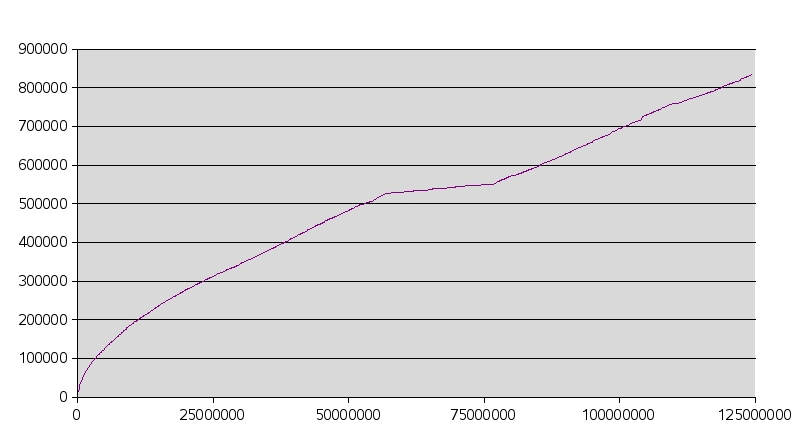
Cumulative dictionary size vs. word count of fil9 (by Alexandru Mosoi).
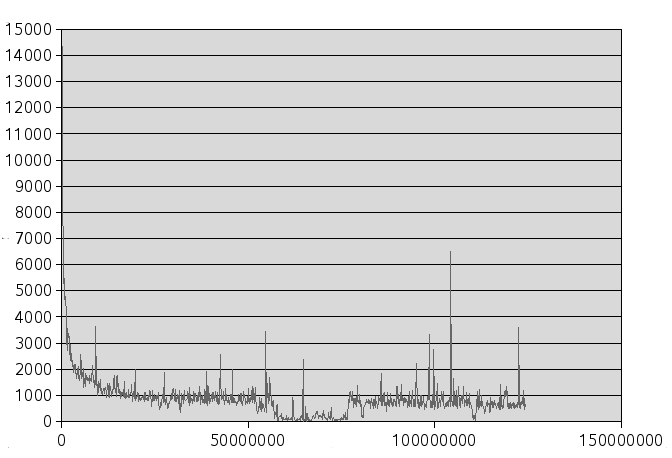
New words added to dictionary (per 217 word block) vs. word count of fil9. This is essentially the derivative of the above graph (by Alexandru Mosoi).
3. Shannon, Cluade E., “Prediction and Entropy of Printed English”, Bell Sys. Tech. J (3) p. 50-64, 1950.
8. Cover, T. M., and R. C. King, “A Convergent Gambling Estimate of the Entropy of English”, IEEE Transactions on Information Theory (24)4 (July) pp. 413-421, 1978.